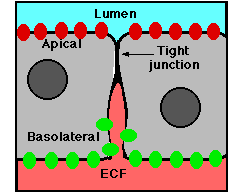In many animal tissues (e.g., connective tissue), each cell is separated from the next by an extracellular coating or matrix.
However, in some tissues (e.g., epithelia), the plasma membranes of adjacent cells are pressed together. Four kinds of junctions occur in vertebrates:In many plant tissues, it turns out that the plasma membrane of each cell is continuous with that of the adjacent cells. The membranes contact each other through openings in the cell wall called

Tight junctions seal adjacent epithelial cells in a narrow band just beneath their apical surface. They consist of a network of claudins and other proteins.
Tight junctions perform two vital functions:A report by Vermeer, et al., in the 20 March 2003 issue of Nature provides a striking example of the role of tight junctions.
The epithelial cells of the human lung expressAs long as the sheet of cells is intact, there is no stimulation of its receptors by heregulin thanks to the seal provided by tight junctions.
However, if the sheet of cells becomes broken, heregulin can reach its receptors. The result is an autocrine stimulation of mitosis leading to healing of the wound.
Several disorders of the lung
increase the permeability of the airway epithelium. The resulting opportunity for autocrine stimulation may account for the proliferation (piling up) of the epithelial cells characteristic of these disorders. Link to pictures showing the proliferation of epithelial cells ("Squamous epithelium") in cigarette smokers. Adherens junctions are built from:
Adherens junctions are built from:
We synthesize some 80 different types of cadherins. In most cases, a cell expressing one type of cadherin will only form adherens junctions with another cell expressing the same type. This is because molecules of cadherin tend to form homodimers not heterodimers.
Inherited mutations in a gene encoding a cadherin can cause stomach cancer. Mutations in a gene (APC), whose protein normally interacts with catenins, are a common cause of colon cancer.
Loss of functioning adherens junctions may accelerateGap junctions are intercellular channels some 1.5–2 nm in diameter. These permit the free passage between the cells of ions and small molecules (up to a molecular weight of about 1000 daltons).
They are cylinders constructed from 12 copies of transmembrane proteins called connexins — 6 copies in one cell juxtaposed with 6 in the connecting cell.
Because ions can flow through them, gap junctions permit changes in membrane potential to pass from cell to cell.
Examples:Desmosomes are localized patches that hold two cells tightly together. They are common in epithelia (e.g., the skin). Desmosomes are attached to intermediate filaments of keratin in the cytoplasm.
Pemphigus is an autoimmune disease in which the patient has developed antibodies against proteins (cadherins) in desmosomes. The loosening of the adhesion between adjacent epithelial cells causes blistering.
Carcinomas are cancers of epithelia. However, the cells of carcinomas no longer have desmosomes. This may partially account for their ability to metastasize.
These are similar to desmosomes but attach epithelial cells to the basal lamina ("basement membrane" – View) instead of to each other.
Pemphigoid is an autoimmune disease in which the patient develops antibodies against proteins (integrins) in hemidesmosomes. This, too, causes severe blistering of epithelia.
Junctional epidermolysis bullosa (JEB). Caused by mutations in one of 3 genes encoding subunits of laminin-332. Without laminin-332, the hemidesmosomes are defective or absent. The result is severe blistering of the epidermis of the skin. [More]

Although each plant cell is encased in a boxlike cell wall, it turns out that communication between cells is just as easy, if not easier, than between animal cells. Fine strands of cytoplasm, called plasmodesmata, extend through pores in the cell wall connecting the cytoplasm of each cell with that of its neighbors.
Plasmodesmata provide an easy route for the movement of ions, small molecules like sugars and amino acids, and even macromolecules like RNA and proteins, between cells. The larger molecules pass through with the aid of actin filaments.
Plasmodesmata are sheathed by a plasma membrane that is simply an extension of the plasma membrane of the adjoining cells. This raises the intriguing question of whether a plant tissue is really made up of separate cells or is, instead, a syncytium: a single, multinucleated cell distributed throughout hundreds of tiny compartments!
| Welcome&Next Search |